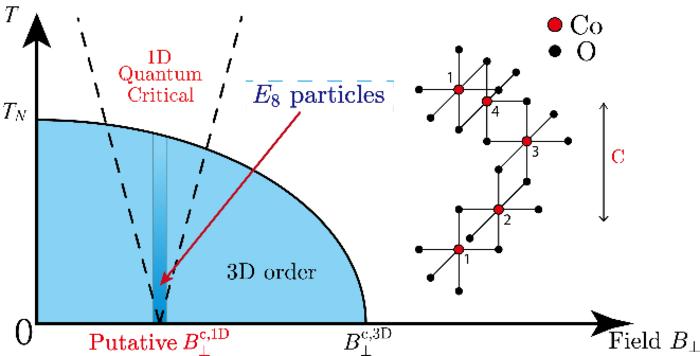Reviewed by Lexie CornerOct 21 2024
The research team led by Professor Jianda Wu at the Tsung-Dao Lee Institute of Shanghai Jiao Tong University, in partnership with Professor Jie Ma from the School of Physics and Astronomy and Professor Bella Lake’s neutron scattering team in Germany, has made significant strides in studying exotic collective excitations within low-dimensional quantum magnetic materials. Their findings were published in Science Bulletin.
 Schematic phase diagram of BCVO with transverse magnetic field applied along the [010] direction. The light blue regions illustrate the three-dimensional antiferromagnetic phase. The dark blue region shows emergence of E8 particles near the putative 1D QCP, respectively. The right figure shows structure of the 1D CoO6 helical chain in BCVO. Image Credit: Science China Press.
Schematic phase diagram of BCVO with transverse magnetic field applied along the [010] direction. The light blue regions illustrate the three-dimensional antiferromagnetic phase. The dark blue region shows emergence of E8 particles near the putative 1D QCP, respectively. The right figure shows structure of the 1D CoO6 helical chain in BCVO. Image Credit: Science China Press.
The low-energy behavior of the Transverse Field Ising Chain (TFIC) at its quantum critical point (QCP) is characterized by a conformal field theory (CFT) with a central charge of 1/2. At the QCP, the introduction of a longitudinal magnetic field leads to the emergence of a quantum integrable system known as the quantum E8 integrable model.
The model's physics is precisely governed by the exceptional E8 Lie algebra, which includes eight distinct types of massive quasiparticles. Their mass spectrum is derived from the roots of the Cartan matrix of the E8 Lie algebra, with the mass ratio of the second particle to the first given by the golden ratio, m2/m1=2cos(π/5)≈1.618.
The model’s simplicity, elegance, and profound physical implications make it essential to study its excitations and identify materials that can realize E8 physics. This research is significant not only for advancing studies in quantum integrable models and statistical field theory, but also for its potential to contribute to the development of novel quantum magnetic devices.
BaCo₂V₂O₈ (BCVO), a well-known quasi-one-dimensional antiferromagnet, has attracted considerable research attention in the past decade, leading to the discovery of various exotic physical phenomena. Notably, when subjected to an external transverse magnetic field, the low-temperature behavior of BCVO near its critical transverse field can be explained by the universality class of the Transverse Field Ising Chain (TFIC).
When a magnetic field is applied along the [100] or [010] direction in BCVO, the critical field for the quantum critical point (QCP) of the TFIC is approximately 5T, significantly lower than the material's three-dimensional quantum critical field of 10T. In the three-dimensional ordered phase, the weak antiferromagnetic interactions among the chains can be effectively modeled as a staggered longitudinal magnetic field perturbation. This led to the theoretical prediction that the magnetic excitations close to the QCP in BCVO would display E8 physics.
Previous studies have confirmed the presence of TFIC universality under these experimental conditions and observed exotic E8 excitation modes at the Brillouin zone center, as reported in works such as PRB(R) (2020), PRB (2021), and PRL (2021).
To fully verify the emergence of complete E8 physics in BCVO within the relevant parameter range, researchers needed to determine the dispersion relations of the quantum E8 particles. In this research, the team employed inelastic neutron scattering techniques to measure the spin dynamics structure factor of BCVO under a transverse magnetic field of approximately 4.7T along the [010] direction.
The experimental results closely matched analytical calculations and numerical simulations, thereby providing definitive experimental confirmation of the presence of quantum E8 particles in BCVO.
The E8 particles, which are exotic excitations emerging from the quantum E8 integrable field theory, exhibit an energy-momentum dispersion relationship that follows the relativistic form E2=p2c2+m2c4, where E, p , and m represent the energy, momentum, and rest mass of the E8 particles, respectively, and c denotes the speed of light (here representing the maximum speed of information propagation within the model).
In BCVO, the four-periodicity of the CoO₆ helical chain structure causes the excitation spectrum to fold twice. Through numerical simulations with the infinite Time Evolving Block Decimation algorithm, the researchers accounted for Brillouin zone folding and identified the relativistic excitation spectrum of the three lightest quantum E8 particles. The observed excitation spectrum is closely aligned with predictions from the quantum E8 integrable field theory. These results confirm the presence of quantum E8 particles in the quasi-one-dimensional antiferromagnet BCVO.
Additionally, the team used experimental data to estimate the upper limit of the information propagation speed (i.e., the effective "speed of light") for low-energy magnetic excitations in BCVO under critical transverse magnetic fields, determining it to be approximately 1600 m/s.
These results broaden the scope of research in statistical field theory, integrable systems, and strongly correlated many-body physics, laying a foundation for future investigations into E8 particle physics and potential physical manipulation of these particles.
The corresponding authors are Prof. Jianda Wu (Tsung-Dao Lee Institute), Prof. Jie Ma (School of Physics and Astronomy), and Prof. Bella Lake (Helmholtz-Zentrum Berlin for Energy and Materials). Xiao Wang, a PhD student under Prof. Wu, is the first author.
Funding was provided by the National Natural Science Foundation of China, the Major Project of Science and Technology Innovation 2030—“Quantum Communication and Quantum Computer,” the Shanghai Natural Science Foundation, and the Shanghai Pujiang Talent Program.
Journal Reference:
Wang, X., et al. (2024). Spin dynamics of the E8 particles. Science Bulletin. doi.org/10.1016/j.scib.2024.07.040.